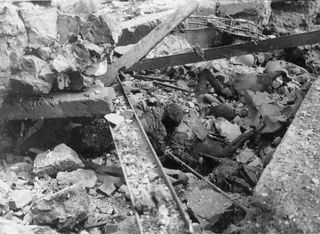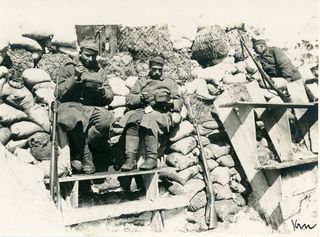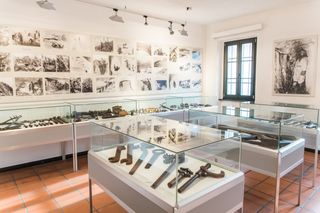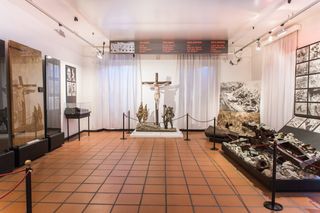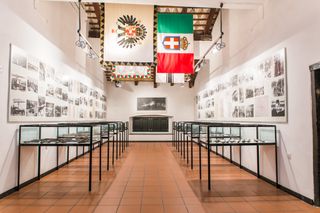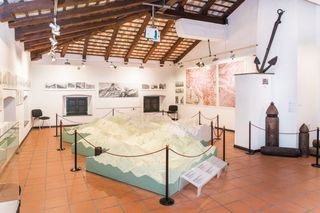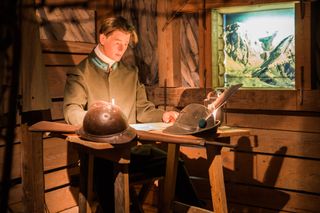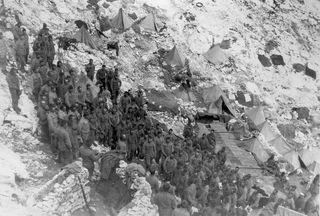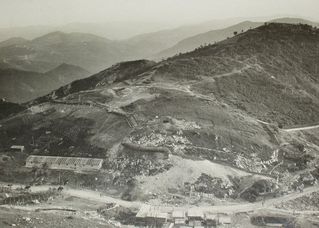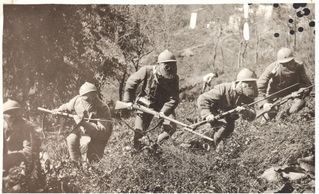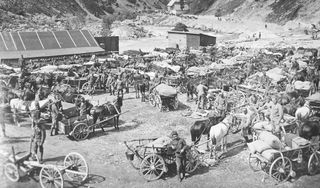Permanent Exhibition
The Kobarid Museum introduces the visitor to the theme of the permanent exhibition with a symbolic layout already in the entrance hall on the ground floor. There are two maps showing European battlefields in the First World War and the shift of political borders after the end of the war, diverse flags, portraits of soldiers of many ethnicities and gravestones from military cemeteries of the Upper Soča Region.
Three rooms on the first floor are dedicated to the turbulent history of Kobarid. The town at the junction of the Soča and the Nadiža valleys which connect Friuli and Carinthia, was the scene of many conflicts and wars due to its very location. In the 20th century, the flag in the Kobarid square was changed as many as ten times. Visitors will find a wealth of information in these rooms, which is welcome before a visit to the Kobarid History Trail and Tonocov grad, an archaeological site of the late antiquity settlement.
The great majority of the museum collection is dedicated to the Isonzo Front which is presented in thematic rooms. This way of mounting the exhibition presents all dimensions of the war. The Krn Room presents the beginning of fights along the Soča River after Italy entered the war on May 24, 1915. The White Room portrays the suffering of soldiers in the wintertime. Before going to the battlefield, none of them could foresee what was to befall them there. The Austro-Hungarian soldiers had previously experienced ten months of battles on the plains of the Russian front and on the Balkans, while most of the Italians had never even been on the battlefield. The Room of the Rear gives account of the rear of the Isonzo Front as having become a veritable "anthill" of hundreds of thousands of soldiers and workers, from Mt. Rombon to the coast of the Gulf of Trieste. The Black Room concludes the narrative of the 29-month fights along the Soča River. It is the room of a warning – it demonstrates the absurdity of war, of soldiers’ suffering, and of more than three hundred thousand of fallen men.
On the second floor, the final act of the Isonzo Front is presented – the Twelfth Isonzo Offensive, or the Battle of Kobarid, i.e. the offensive by the joint German and Austro-Hungarian troops. The scope of this battle is illustrated by means of the 27m2 raised relief map of the Upper Soča Region (1:5000) with an animated display of the course of the battle.
An even more personally presented story is offered by the audio recording of a soldier's letter to his father in the "Italian cave". The narrative and the background music, provided by the Friulian folk song Stellutis alpinis, touch the emotions and encourage visitors to think about the distress and suffering experienced by soldiers on both sides of the front.
A documentary film, available to visitors in eleven languages, provides a more detailed description of the events on the front.
August 2, 1915
"Today I continue writing my diary. It was not possible to do it during the four days I spent on Batognica. In these days I experienced the full horrors of the utmost terrible war. It didn't stop raining even for a moment. It was so extremely cold that as many as fifty men from our battalion came down from the mountain with frozen feet. On the 29th I was in a trench for 24 hours, crouching all the time among the dead bodies, ours and the enemy's. The stench was abominable, and to top it all, we had to resist a violent enemy attack, which we managed to repel. Many of our fallen comrades were hit in the head as they tried and rose over their breastplates to fire.
The food is meagre and mainly consists of bread, tasteless and cold cooked meat and some tinned food. Water is brought in water-skins, it is scarce and stinks. I neither ate nor drank for two days. Due to the stench of corpses, the bitter cold, the undrinkable water, the lack of sleep because of constant alarms. All of this put me into a pitiable state…”
(Virgilio Bonamore – from the unpublished diary of a bersaliere; archives of the Kobarid Museum)

